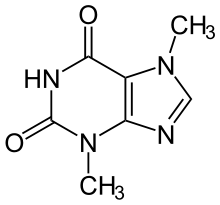Theobromine poisoning
Theobromine poisoning, also informally called, chocolate poisoning, is an overdosage reaction to the xanthine alkaloid theobromine, found in chocolate, tea, cola beverages,[1] and some other foods. Median lethal (LD50) doses of theobromine have only been published for cats, dogs,[2] rats, and mice; these differ by a factor of 6 across species. At doses of 0.8-1.5 g (50-100 g cocoa) per day sweating, trembling and severe headaches were noted. Limited mood effects were shown at 250mg/day and negative mood effects above.[3]
| Animal | Oral toxicity (mg/kg) | |
|---|---|---|
| TDLo | LD50 | |
| Cat | 200 | |
| Dog | 16 | 300 |
| Human | 26 | ~1,000 |
| Mouse | 837 | |
| Rat | 1,265 | |

Chocolate
In humans
Cocoa beans contain about 1.2% theobromine by weight,[4] so 28 g (1 ounce) of raw cocoa contains approximately 0.3 g theobromine. Processed chocolate, in general, has smaller amounts. The amount found in highly refined chocolate candies or sweets (typically 1.4–2.1 g/kg or 40–60 mg/oz) is much lower than that of dark chocolate or unsweetened baker's chocolate (>14 g/kg or >400 mg/oz). In general, the amount of theobromine found in chocolate is small enough that chocolate can be safely consumed by humans with a negligible risk of poisoning.[5]
In other species
Serious poisoning happens more frequently in domestic animals, which metabolize theobromine much more slowly than humans, and can easily consume enough chocolate to cause poisoning. The most common victims of theobromine poisoning are dogs,[6][7] for which it can be fatal. The toxic dose for cats is even lower than for dogs.[8] However, cats are less prone to eating chocolate since they are unable to taste sweetness.[9] Theobromine is less toxic to rats, mice, and humans, who all have an LD50 of about 1,000 mg/kg.
In dogs, the biological half-life of theobromine is 17.5 hours; in severe cases, clinical symptoms of theobromine poisoning can persist for 72 hours.[10] Medical treatment performed by a veterinarian involves inducing vomiting within two hours of ingestion and administration of benzodiazepines or barbiturates for seizures, antiarrhythmics for heart arrhythmias, and fluid diuresis. Theobromine is also suspected to induce right atrial cardiomyopathy after long term exposure at levels equivalent to ~15 g of dark chocolate per kg of weight and per day.[11] According to the Merck Veterinary Manual, baker's chocolate of approximately 1.3 g/kg (0.02 oz/lb) of a dog's body weight is sufficient to cause symptoms of toxicity.[12] For example, 0.4 ounces (11 g) of baker's chocolate would be enough to produce mild symptoms in a 20-pound (9.1 kg) dog, while a 25% cacao chocolate bar (like milk chocolate) would be 25% as toxic as the same dose of baker's chocolate.[13] One ounce of milk chocolate per pound of body weight is a potentially lethal dose in dogs.[12]
In previous research, the USDA investigated the possible use of theobromine as a toxicant to control coyotes preying on livestock.[14]
Symptoms
The first signs of theobromine poisoning are nausea, vomiting, diarrhea, and increased urination. These can progress to cardiac arrhythmias, epileptic seizures, internal bleeding, heart attacks, and eventually death.
See also
- Xanthine oxidase
Footnotes
- Gennaro, M. C.; Abrigo, C. (1992). "Caffeine and theobromine in coffee, tea and cola-beverages or any other fizzy drinks". Fresenius' Journal of Analytical Chemistry. 343 (6): 523–525. doi:10.1007/BF00322162. ISSN 0937-0633.
- "Chocolate Poisoning in Dogs | NASC LIVE". NASC LIVE. Retrieved 2018-11-07.
- "3,7-Dimethylxanthine".
- Pomeroy, Steven Ross. "1,900: The Number Of Chocolates That Will Kill a Child". Forbes. Retrieved 2017-12-03.
- "3,7-Dimethylxanthine: Theobromine". Hazardous Substances Data Bank, Toxnet, US National Library of Medicine. 1 December 2017. Retrieved 7 November 2018.
- "Dog owners get chocolate warning". BBC. December 30, 2008. Retrieved July 28, 2009.
- "Greedy dog cheats chocolate death". BBC. April 3, 2009. Retrieved July 28, 2009.
- "The Poisonous Chemistry of Chocolate". WIRED. 14 February 2013.
- Biello, David (August 16, 2007). "Strange but True: Cats Cannot Taste Sweets". Scientific American. Retrieved July 28, 2009.
- Gwaltney-Brant, Sharon (February 2001). "Chocolate Intoxication" (PDF). Veterinary Medicine Publishing Group. Retrieved April 5, 2016.
- H. Gans, Joseph (1980). "Effects of short-term and long-term theobromine administration to male dogs". Toxicology and Applied Pharmacology. 53 (3): 481–496. doi:10.1016/0041-008X(80)90360-9.
- "Merck Veterinary Manual". Retrieved 2014-06-17.
- "PetMD". Retrieved 2014-06-17.
- Johnston, John J. (2005). "Evaluation of Cocoa- and Coffee-Derived Methylxanthines as Toxicants for the Control of Pest Coyotes". Journal of Agricultural and Food Chemistry. Retrieved July 28, 2009.
References
- Theobromine in the ChemIDplus database (September 9, 2004)
- Merck Veterinary Manual (Toxicology/Food Hazards section), Merck & Co., Inc., Chocolate Poisoning. (June 16, 2005)
External links
- Chocolate Toxicity Calculator
- Dog Chocolate Toxicity Meter
- A Pet Owner's Guide to Poisons: Chocolate at the Wayback Machine (archived August 5, 2009)
- Toxicity basic facts